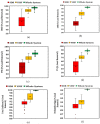Assessment of pathogen removal efficiency of vertical flow constructed wetland treating septage
- PMID: 37907513
- PMCID: PMC10618516
- DOI: 10.1038/s41598-023-45257-2
Assessment of pathogen removal efficiency of vertical flow constructed wetland treating septage
Abstract
Septage refers to the semi-liquid waste material that accumulates in septic tanks and other onsite sanitation systems. It is composed of a complex mixture of human excreta, wastewater, and various solid particles. Septage is a potential source of water pollution owing to presence of high organic content, significant pathogen concentrations, and a range of nutrients like nitrogen and phosphorus. The harmful impacts of septage pollution poses significant risks to public health through the contamination of drinking water sources, eutrophication of water bodies and spread of water borne diseases. Conventional septage treatment technologies often face limitations such as high operational costs, energy requirements, and the need for extensive infrastructure. Therefore, with an aim to treat septage through an alternative cost effective and energy-efficient technology, a laboratory-scale constructed wetland (CW) system (0.99 m2) consisting of a sludge drying bed and a vertical flow wetland bed was utilized for the treatment of septage. The sludge drying bed and vertical flow beds were connected in series and filled with a combination of gravel with varying sizes (ranging from 5 to 40 mm) and washed sand. Canna indica plants were cultivated on both beds to facilitate phytoremediation process. The system was operated with intermittent dosing of 30 Ltrs of septage every day for 2 months. The HRT of the system was fixed at 48 h. The average inlet loads of Biochemical Oxygen Demand (BOD5), Chemical Oxygen Demand (COD), and Total Suspended Solids (TSS) were measured as 150 ± 65.7 g m-2 day-1, 713 ± 443.9 g m-2 day-1, and 309 ± 66.3 g m-2 day-1, respectively. After treatment, the final effluent had an average load of 6 g m-2 day-1 for BOD5, 15 g m-2 day-1 for COD, and 51 g m-2 day-1 for TSS, indicating that the CW system achieved an average removal efficiency of 88% for BOD, 87% for COD, and 65% for TSS. The average load of total coliforms and helminthes eggs in the influent was recorded as 4 × 108 Colony-Forming Units (CFU) m-2 day-1 and 3 × 107 eggs m-2 day-1, respectively. However, the CW system demonstrated significant effectiveness in reducing microbial contamination, with an average removal efficiency of 99% for both total coliforms and helminthes eggs. The vertical flow constructed wetland system, equipped with pretreatment by sludge drying bed, has proven to be efficient in treatment of septage.
© 2023. The Author(s).
Conflict of interest statement
The authors declare no competing interests.
Figures




References
-
- López D, Leiva AM. Influence of design and operational parameters on the pathogens reduction in constructed wetland under the climate change scenario. Rev. Environ. Sci. Biotechnol. 2019;18(1):101–125. doi: 10.1007/s11157-019-09493-1. - DOI
-
- Datta A, Singh HO, Raja SK, Dixit S. Constructed wetland for improved wastewater management and increased water use efficiency in resource scarce SAT villages: A case study from Kothapally village India. Int. J. Phytoremediation. 2021;23(10):1067–1076. doi: 10.1080/15226514.2021.1876627. - DOI - PubMed
-
- Nzouebet WAL, Kengne ES, Rechenburg A, Ndangang JJN, Noumsi IMK. Fecal sludge treatment in a pilot-scale vertical-flow constructed wetland for the removal of helminth eggs. J. Water Sanit. Hyg. Dev. 2022;12(9):634–646. doi: 10.2166/washdev.2022.090. - DOI
-
- Darvishmotevalli M, Moradnia M, Asgari A, Noorisepehr M, Mohammadi H. Reduction of pathogenic microorganisms in an imhoff tank-constructed wetland system. Desalin. Water Treat. 2019;154:283–288. doi: 10.5004/dwt.2019.24044. - DOI
Publication types
MeSH terms
Substances
LinkOut - more resources
Full Text Sources

